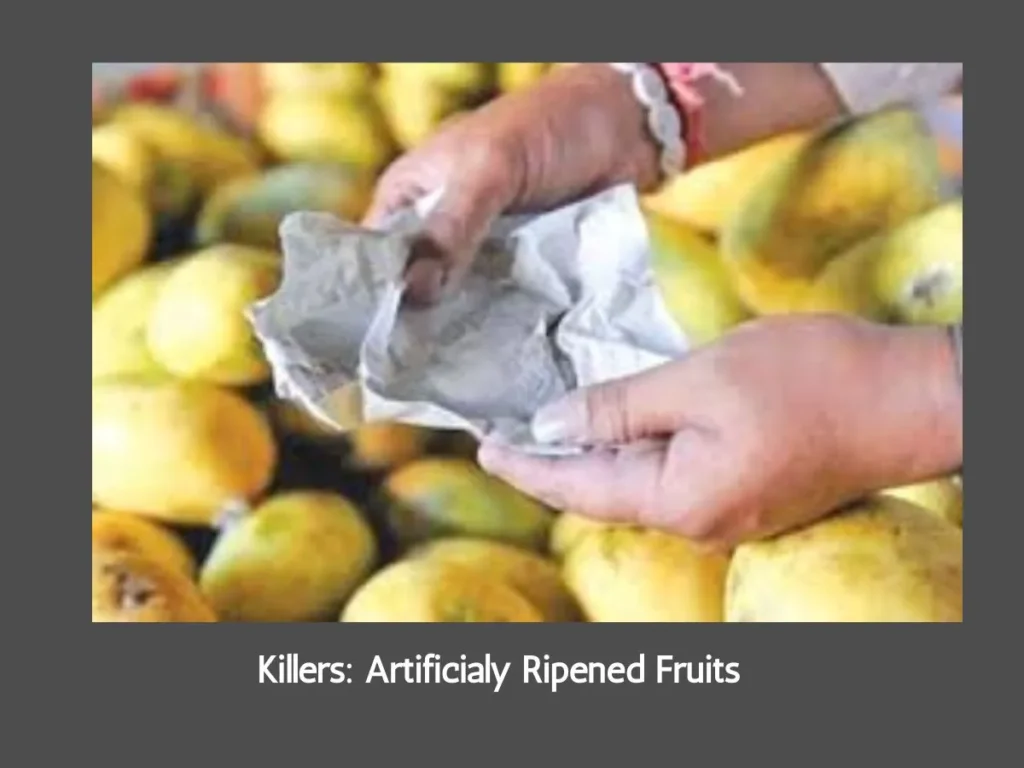Table of Contents
ToggleAre You Eating Artificially Ripened Fruits in 2025?

This article aims to provide a comprehensive guide on identifying artificially ripened fruits, ensuring you can make informed choices for your health and taste preferences. In today’s global market, the demand for fresh fruits year-round has led to the widespread practice of artificial ripening. While this allows consumers to enjoy their favorite fruits regardless of the season, it also raises concerns about the quality, safety, and taste of these fruits. New year 2025 ia coming with lot of Happiness and new opportunities. Don’t let this joy and happiness overcome by fake and adulterated food items and keep yourself fit and fine to welcome New Year 2025.
Understanding Artificial Ripening
Artificial ripening involves the use of chemicals or gases to speed up the ripening process of fruits after they have been harvested.
Common agents include:
Ethylene Gas: A natural plant hormone often used to ripen fruits uniformly.
Calcium Carbide: A chemical that, when in contact with moisture, produces acetylene gas, which mimics ethylene’s effects.
Ethephon: A chemical that releases ethylene gas upon decomposition.
While ethylene gas is generally considered safe, the use of calcium carbide is banned in many countries due to its potential health hazards, including carcinogenic effects.
While ethylene gas is generally considered safe, the use of calcium carbide is banned in many countries due to its potential health hazards, including carcinogenic effects.
Signs of Artificial Ripening
Uniform Color
One of the most obvious signs of artificially ripened fruits is an unnaturally uniform color. For instance:
Bananas: Artificially ripened bananas are uniformly yellow without the natural brown spots that develop on naturally ripened bananas.
Mangoes: These may appear bright yellow or orange uniformly, lacking the natural green or yellow gradient.
Tomatoes: Often very red all over but may still be hard and lack the natural gradation of color seen in vine-ripened tomatoes.
Taste and Aroma
The taste and aroma of fruits are often the best indicators of their ripening process:
Bananas: Naturally ripened bananas have a sweet, intense aroma, whereas artificially ripened ones may lack this scent.
Mangoes: Naturally ripened mangoes are rich in flavor and smell sweet. Artificially ripened mangoes might taste bland or slightly chemical.
Texture
Artificially ripened fruits can have an inconsistent texture:
Bananas: May feel too firm or overly soft and mushy.
Mangoes: Often spongy and lack the fibrous texture of naturally ripened mangoes.
Papayas: Artificially ripened papayas may be soft to touch but still green inside.
Unripe Signs
Look for signs of uneven ripeness:
Bananas: Can have green tips and ends while the rest of the fruit is yellow.
Tomatoes: May be red outside but still green or white near the stem.
Ripening Agent Residue
Sometimes, chemical residues can be visible on the fruit’s skin:
Mangoes and Bananas: Calcium carbide can leave a powdery residue on the skin.
Tomatoes: May have a thin film that can be wiped off.
Speed of Ripening
Artificially ripened fruits often spoil faster:
Bananas: Ripen very quickly and then become overly soft and black.
Mangoes: May start to rot from the inside out soon after ripening.
Taste Test
Chemical agents can alter the taste:
Bananas and Mangoes: Can sometimes have an off or slightly chemical taste, indicating the use of artificial ripening agents.

Health Implications of Artificial Ripening
The use of chemicals like calcium carbide can pose serious health risks:
Carcinogenic Effects: Calcium carbide contains arsenic and phosphorus, which are known carcinogens.
Respiratory Issues: Acetylene gas, produced by calcium carbide, can cause respiratory problems.
Gastrointestinal Problems: Consumption of such fruits can lead to stomach disorders and other health issues.
Ethylene gas, however, is generally considered safe as it is a natural ripening hormone.
How to Choose Naturally Ripened Fruits
Buy Local and Seasonal
Fruits in season are more likely to be naturally ripened and fresher. Buying local reduces the need for artificial ripening since the fruits don’t have to endure long transport times.
Check the Source
Purchase fruits from trusted sources. Organic markets and local farmers’ markets are often less likely to use artificial ripening methods.
Inspect the Fruit
Use the characteristics mentioned above to inspect fruits carefully before purchasing. Look for natural color gradients, strong aroma, and consistent texture.
Ripen Fruits at Home
Buy fruits that are slightly underripe and allow them to ripen at home. For example, placing bananas in a brown paper bag can speed up natural ripening due to the ethylene gas they emit.
Conclusion
Being aware of the signs of artificially ripened fruits can help you make healthier and more delicious choices. By opting for naturally ripened fruits, you not only enhance your eating experience but also avoid potential health risks associated with chemical ripening agents. Always prioritize buying local, seasonal fruits and take the time to inspect them carefully. This way, you can enjoy fruits that are not only safer but also richer in flavor and nutrients.
By understanding these differences, you can ensure that you and your family consume only the best quality fruits. Stay informed, stay healthy, and enjoy the natural goodness of fresh fruits.
